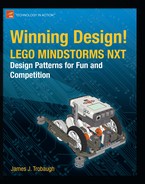Book Description
Winning Design! LEGO Mindstorms NXT Design Patterns for Fun and Competition is about design that works. It's about building with LEGO MINDSTORMS NXT for fun, for education, but especially for competition. Author James Trobaugh is an experienced coach and leader in the FIRST LEGO League. In this book, he shares his hard-won knowledge about design principles and techniques that contribute to success in robotics competitions.
Successful design for competition recognizes that at the critical moment, at the moment when the most people are watching, at the moment when you are the most stressed, that you have only one chance to "get it right". You therefore need designs that are proven and robust, that will withstand variation such as from a battery running down its charge, that won't be thrown off by changing light levels, that will repeatedly do just what you have designed them to do, no more, no less.
Winning Design! unlocks the secrets of reliable design using LEGO MINDSTORMS NXT. You'll learn proven design patterns that you can employ for common tasks such as turning, pushing, pulling. You'll reduce and compensate for variation in performance from battery charge levels and motor calibration differences. You'll produce designs that won't frustrate you by not working, but that will delight you with their reliable performance in the heat of competition.
Written by a coach who knows what it takes to field a winning team in competition
Useful to coaches who teach, and to students wanting to grow their skills
Presents proven design patterns that help take the stress out of competing
Table of Contents
- Copyright
- About the Author
- About the Technical Reviewer
- Introduction
- 1. Introduction
- 1. Design Considerations
- 2. Chassis Design
- 2. Navigation
- 3. Going Straight
- 4. Consistent Turning
- 5. Line Following and Detection
- 6. Squaring Up
- 7. Collision Detection
- 3. Manipulation
- 8. Passive Attachments
- 9. Power Attachments
- 10. Pneumatics
- 4. Programming
- 11. Master Programs
- 12. Program Management
- 13. Documentation and Presentation
- A. Building DemoBot
- B. Building the Motor Matching Machine
